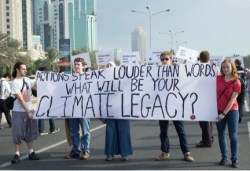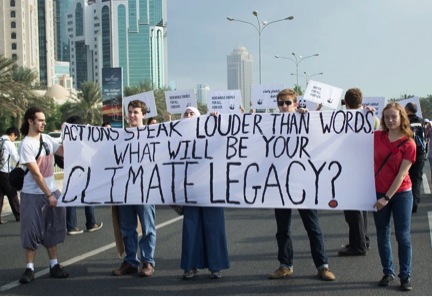 For more than 18 years, negotiators representing countries big and small have come together at this time of year under the auspices of the United Nations to talk about how we are going to avoid the worst of climate change. For the 40,000 or so people who attend the climate negotiations each year, it has become something of a holiday tradition — and as with any family, the global family of nations is ripe with characters and disagreements that never seem to get resolved.
For more than 18 years, negotiators representing countries big and small have come together at this time of year under the auspices of the United Nations to talk about how we are going to avoid the worst of climate change. For the 40,000 or so people who attend the climate negotiations each year, it has become something of a holiday tradition — and as with any family, the global family of nations is ripe with characters and disagreements that never seem to get resolved.
But this year, youth activists from around the world are determined to prevent this reunion of nations from becoming a cheery festival of business-as-usual and deal-swapping with big fossil fuel companies.
Each year, a different family member hosts all the other nations. This year tiny little Qatar stepped up to show off a new tree-inspired conference center and other products of its enormous oil wealth, and hoped that negotiators interested in kicking back with stiff beverages would be satiated with copious amounts of tea — Qatar is alcohol-free.
The negotiations were rung in with blaring alarms from the World Bank [PDF] and U.N. Environmental Program, both of which released reports excoriating nations for inadequate progress in that subtle way that international agencies do, with long statements and lots of numbers. The World Bank’s President Jim Yong Kim was more frank in a conference call announcing the bank’s report when he said, “We will never end poverty if we don’t tackle climate change.”
Youth activists welcomed conference goers sliding along moving sidewalks with signs that asked, “What will your climate legacy be?” and offering reminders to negotiators of the dim legacy of climate disasters they have already set in motion.
U.S. youth at the negotiations are focused on the White House, where action on climate change is essential during President Obama’s second term. Last year at the negotiations, nations agreed that 2015 was the next occasion to aim for a global treaty. In the interim, work is focused on getting the financing together to help developing countries grow their economies in a sustainable manner, sorting out disputes about whose responsibility it is to reduce emissions, and laying out a framework that nations can agree and stick to.
Things would have begun well enough, but the U.S.’s top negotiator, Jonathan Pershing, began by appealing to the hall of nations that the U.S. had made “enormous” efforts to address climate change, eliciting a rousing guffaw from civil society, developing nations, and probably just about everyone else. Things didn’t get any better when the next day reports out of Washington indicated the president had quietly signed legislation that excludes U.S. airlines from the European Union’s emission standards.
But while the official negotiations are heavy on talk and light on action, outside the meetings there are signs that people — young people in particular — are ready for real change. Over the weekend, hundreds rallied in the streets of Doha to call on the Arab world to act on climate change. The march — the first to be allowed in modern-day Qatar — was led by a coalition of non-governmental organizations including the Arab Youth Climate Movement.
Meanwhile, in our own oil-rich country, U.S. youth are sitting in trees and locking down to heavy equipment to stop the Keystone XL pipeline; students on over 100 college campuses and growing are calling for their schools to divest from fossil fuels; and thousands have devoted their energy to starting up businesses and organizations with environmental and social missions at their forefront to build a new economy. Amid a vacuum of national leadership on climate change, youth are filling in the void.
As the second week of the Doha climate talks gets into full swing, and heads of states from the wealthiest countries call in to remind negotiators that their national interests will not bow to any kind promise of a multilateral agreement, it seems this annual holiday gathering will continue to prove inadequate for at least another year. For now, it falls to us to fulfill our own holiday wish lists. It falls to people young and old to come together and build the political pressure to keep the rising seas at bay.
I think we’re ready for this, and I look forward to the holidays in 2050 when I’ll be 63 and can say that it was hard, but we did it — and look how strong the economy is, how clean our air is, and how much happier we are. That will be a legacy worth leaving.



